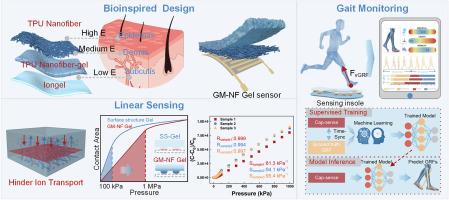Ultra-linear flexible pressure sensors via skin-inspired gradient engineering
IF 14.2
1区 材料科学
Q1 ENGINEERING, MULTIDISCIPLINARY
引用次数: 0
Abstract
Flexible pressure sensors face an irreconcilable trade-off among linearity, sensitivity, and signal stability due to viscoelastic creep. Inspired by the gradient modulus characteristics of human skin, this study employs electrospinning to construct a heterogeneous structure composed of a high-modulus nanofiber network embedded in a low-modulus ionic gel. This structure mimics epidermal rigidity (high-modulus nanofiber layer), dermal viscoelasticity (fiber-gel hybrid), and hypodermal compliance (soft ionic matrix) to synergistically redistribute stress and suppress ion migration. The sensor achieves breakthrough performance: a wide linear range (1 MPa) with near-perfect linearity (R2 = 0.999) and ultrahigh sensitivity (81.3 kPa−1), yielding a record linear sensing factor (LSF, 81,300). Simultaneously, it exhibits ultralow creep (1.76 % signal drift under sustained loading)—96.8 % lower than non-structured iongels—enabled by nanofiber-restricted ion pathways. Theoretical modeling reveals a dynamic compensation mechanism where pressure-induced changes in dielectric properties, contact area expansion, and electric double-layer thinning interact linearly. Laboratory validation demonstrates high-fidelity plantar pressure monitoring during gait cycles and machine learning-based prediction of vertical ground reaction forces with exceptional accuracy (R2 > 0.95). This work establishes a new design paradigm for high-precision flexible sensing by fundamentally resolving long-standing material limitations.

超线性柔性压力传感器通过皮肤启发的梯度工程
由于粘弹性蠕变,柔性压力传感器在线性度、灵敏度和信号稳定性之间面临着不可调和的权衡。受人体皮肤梯度模量特性的启发,本研究采用静电纺丝技术构建了嵌入在低模量离子凝胶中的高模量纳米纤维网络组成的非均相结构。这种结构模仿表皮刚性(高模量纳米纤维层)、真皮粘弹性(纤维-凝胶杂交)和皮下顺应性(软离子基质),协同重新分配应力并抑制离子迁移。该传感器实现了突破性的性能:宽线性范围(1 MPa),线性度接近完美(R2 = 0.999),超高灵敏度(81.3 kPa−1),产生创纪录的线性感测因子(LSF, 81,300)。同时,它表现出超低蠕变(在持续载荷下信号漂移为1.76%),比纳米纤维限制离子通路的非结构化离子低96.8%。理论模型揭示了一种动态补偿机制,其中压力引起的介电性能变化,接触面积膨胀和电双层减薄线性相互作用。实验室验证证明了步态周期期间的高保真足底压力监测和基于机器学习的垂直地面反作用力预测具有极高的准确性(R2 > 0.95)。这项工作从根本上解决了长期存在的材料限制,为高精度柔性传感建立了一个新的设计范式。
本文章由计算机程序翻译,如有差异,请以英文原文为准。
求助全文
约1分钟内获得全文
求助全文
来源期刊

Composites Part B: Engineering
工程技术-材料科学:复合
CiteScore
24.40
自引率
11.50%
发文量
784
审稿时长
21 days
期刊介绍:
Composites Part B: Engineering is a journal that publishes impactful research of high quality on composite materials. This research is supported by fundamental mechanics and materials science and engineering approaches. The targeted research can cover a wide range of length scales, ranging from nano to micro and meso, and even to the full product and structure level. The journal specifically focuses on engineering applications that involve high performance composites. These applications can range from low volume and high cost to high volume and low cost composite development.
The main goal of the journal is to provide a platform for the prompt publication of original and high quality research. The emphasis is on design, development, modeling, validation, and manufacturing of engineering details and concepts. The journal welcomes both basic research papers and proposals for review articles. Authors are encouraged to address challenges across various application areas. These areas include, but are not limited to, aerospace, automotive, and other surface transportation. The journal also covers energy-related applications, with a focus on renewable energy. Other application areas include infrastructure, off-shore and maritime projects, health care technology, and recreational products.
 求助内容:
求助内容: 应助结果提醒方式:
应助结果提醒方式:


